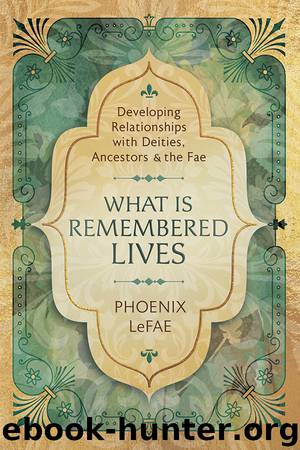What Is Remembered Lives by Phoenix LeFae

Author:Phoenix LeFae
Language: eng
Format: epub
Tags: CVR12212018;phoenix le fae;phoenix lefay;what is remembered lives;honoring ancestors;spirit guides;familiars;faeries;fairies;relationships with ancestors;relationships with the fae;the fae;fae;gods;goddesses;deities
Publisher: Llewellyn Worldwide, LTD.
Published: 2019-08-26T17:17:36+00:00
Thor
Thor Culture
Thor is described as being a massive hulk of a man with a large red beard, red hair, and occasionally red eyes as well. His appetite was well known and seemed to be endless. Some descriptions of him paint him as rather dull and witless—all brawn and no brain—but he was excellent with battle tactics. He was not known for his sense of humor anciently, but my modern experience of him suggests that he may have grown over the years.
Although Thor was a prominent God throughout the Germanic and Scandinavian regions, most of the written texts we have of him are from Iceland. This is true for much of what we know of the Norse and Germanic deities.
One of the messages that’s repeated over and over about the Thunder God is that he was a God of the people. The people who gave him offerings were warriors, farmers, mothers, clan leaders, and healers. Thor was the “everyman’s” God and protector of all the realms.
His greatest enemy is the sea serpent Jormungand, a monster capable of destroying all the worlds. Jormungand has a serpent-like body that is wrapped around Midgard, the human realms. The sea snake keeps this realm hostage, ever tightening his grip on the land. This is further evidence of Thor being a God of humanity, as his greatest enemy is the beast working to destroy the human realms.
However, Jormungand is not Thor’s only enemy. He also fights against the giants, the Jotnar. The Jotnar are the forces of nature, the big primeval forces that cannot be contained. Thor’s work is never done, and in the sagas (a collection of tales from the Scandinavian ancients), he never finishes fighting the Jotnar. These forces will always exist, they will always be present, but he helps to keep them under control.
Thor was also called upon by the people to “hallow” places, items, or events. There are runic inscriptions and prayers to Thor that survive today in which people asked Thor to hallow their harvest, their wedding, or some other human event. Hallow means to honor as holy. Clearly, Thor was more than just a protector; he was also one who offered blessings.
His weapon of choice, his hammer, called Mjölnir, was able to destroy, crush, and obliterate. A basic concept of magick—what can cure can kill—suggests that Thor’s hammer was also able to grow, bless, and mend. Thor was known as the thunder, while Mjölnir was the lightning.
The relationship of thunder and lightning as symbols of health and fertility can be seen in Thor’s relationship to his wife, Sif. Sif was known for her long, golden hair. She was a Goddess of the grain and the fields. Fertility came from a union between earth and sky, Sif being the earth and Thor being the sky. There are still folk beliefs in Scandinavian countries that fields of grain need to be struck by lightning before they are fertile. Any field struck by lightning is considered blessed by the union of Thor and Sif.
Download
This site does not store any files on its server. We only index and link to content provided by other sites. Please contact the content providers to delete copyright contents if any and email us, we'll remove relevant links or contents immediately.
| Paganism | Wicca |
| Witchcraft |
Becoming Supernatural by Dr. Joe Dispenza(7106)
Tools of Titans by Timothy Ferriss(6947)
The Witchcraft of Salem Village by Shirley Jackson(6584)
Inner Engineering: A Yogi's Guide to Joy by Sadhguru(5897)
The Four Agreements by Don Miguel Ruiz(5511)
The Power of Now: A Guide to Spiritual Enlightenment by Eckhart Tolle(4755)
The Wisdom of Sundays by Oprah Winfrey(4626)
Room 212 by Kate Stewart(4107)
Fear by Osho(4085)
Pale Blue Dot by Carl Sagan(4001)
The David Icke Guide to the Global Conspiracy (and how to end it) by David Icke(3882)
Rising Strong by Brene Brown(3781)
Animal Frequency by Melissa Alvarez(3755)
How to Change Your Mind by Michael Pollan(3679)
Sigil Witchery by Laura Tempest Zakroff(3652)
Real Magic by Dean Radin PhD(3568)
Secrets of Antigravity Propulsion: Tesla, UFOs, and Classified Aerospace Technology by Ph.D. Paul A. Laviolette(3450)
The Art of Happiness by The Dalai Lama(3384)
Man and His Symbols by Carl Gustav Jung(3315)
